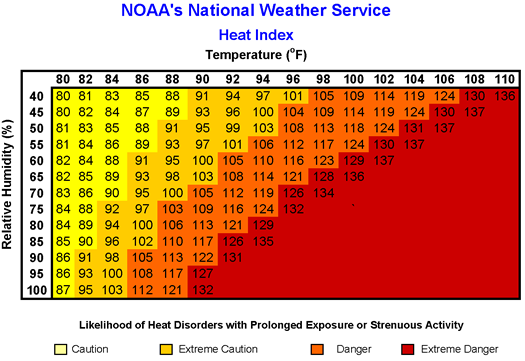Disaster Tip of The Week: Staying Safe In the Summer Heat
 Monday, July 1, 2013 at 2:10PM | |
Monday, July 1, 2013 at 2:10PM | |  Email Article
Email Article

Heat is a major killer. In fact heat is the number one weather related killer. During a heat wave in 1980 there were 1250 heat related deaths. In 1995 during a heat wave 700 people in Chicago died. In 2003 during the EU summer heat wave 50,000 people died. In France alone the number of lives lost was about 15,000 people.
The temperatures in my area has been over 100⁰ F for the last week and looks to continue that way well into this weekend. While this is not out of the ordinary for where I live there is another factor that coupled with this can cause issues. As of today there is a major transportation strike and many more cars are out on the road.
During such times the National Weather Service will issue heat related warnings. These warnings are as follows:
- Excessive Heat Watch - Conditions are favorable for an excessive heat event to meet or exceed local Excessive Heat Warning criteria in the next 24 to 72 hours.
- Excessive Heat Warning - Heat Index values are forecasting to meet or exceed locally defined warning criteria for at least 2 days (daytime highs=105-110° Fahrenheit).
- Heat Advisory - Heat Index values are forecasting to meet locally defined advisory criteria for 1 to 2 days (daytime highs=100-105° Fahrenheit).

Heat-Related Illness Symptoms and First Aid
HEAT CRAMPS
- Symptoms:
- Painful muscle cramps and spasms usually in legs and abdomen
- Heavy sweating
- First Aid:
- Apply firm pressure on cramping muscles or gentle massage to relieve spasm.
- Give sips of water, if nausea occurs, discontinue water
HEAT EXHAUSTION
- Symptoms:
- Heavy sweating
- Weakness
- Cool, pale, clammy skin
- Weak pulse
- Possible muscle cramps
- Dizziness
- Nausea and vomiting
- Fainting
- Normal temperature possible
- First Aid:
- Move person to a cooler environment
- Remove or loosen clothing
- Apply cool, wet cloths
- Fan or move victim to air conditioned room
- Offer sips of water. If nausea occurs, discontinue water. If vomiting continues, seek immediate medical attention.
HEAT STROKE (or sunstroke)
- Symptoms:
- Altered mental state
- Possible throbbing headache, confusion, nausea, dizziness, shallow breathing
- High body temperature (106°F or higher)
- Skin may be hot and dry, or patient may be sweating
- Rapid pulse
- Possible unconsciousness
- First Aid:
- Heat stroke is a severe medical emergency. Summon emergency medical assistance or get the victim to a hospital immediately. Delay can be fatal.
- Move the victim to a cooler, preferably air-conditioned, environment
- Reduce body temperature with a water mister and fan or sponging
- Use fan if heat index temperatures are below the high 90s
- Use extreme caution
- If temperature rises again, repeat process
- Do NOT give fluids







